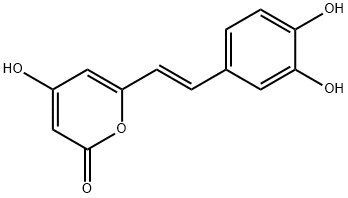Hispidin is a polyphenol originally isolated from
P. hispidus that has diverse biological activities, including antioxidant, anti-inflammatory, and cytoprotective properties.
1,2,3,4 In a trolox equivalent antioxidant capacity (TEAC) assay, hispidin scavenges radicals at 14.47 equivalents of trolox (Item No.
10011659).
2 It inhibits transcriptional activity of NF-κB, decreases inducible nitric oxide synthase (iNOS) expression, and decreases the generation of reactive oxygen species (ROS) in LPS-induced macrophage RAW 264.7 cells.
3 Hispidin inhibits apoptosis and increases insulin secretion in hydrogen peroxide-treated RINm5F pancreatic β-cells.
4 It inhibits protein kinase C β (PKCβ; IC
50 = 2 μM) with no activity against alkaline phosphatase.
5 Hispidin also inhibits β-secretase (BACE1; IC
50 = 4.9 μM) and prolyl endopeptidase (PE; IC
50 = 16 μM) but not other serine proteases when used at a concentration of 40 μM (0.6, 0, 8.2, and 3.1% inhibition of chymotrypsin, trypsin, elastase, and tumor necrosis factor-α converting enzyme (TACE), respectively).
6 
